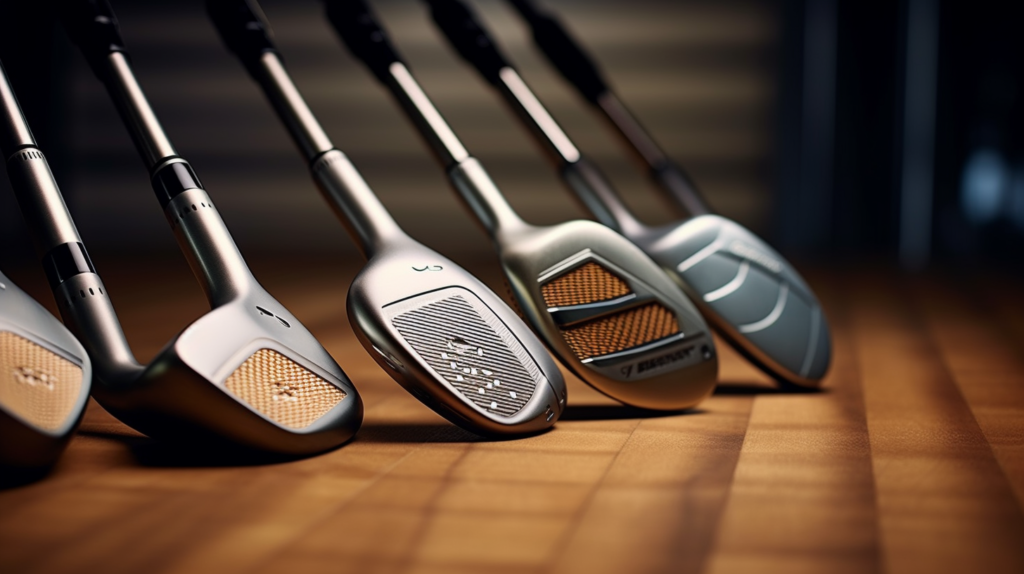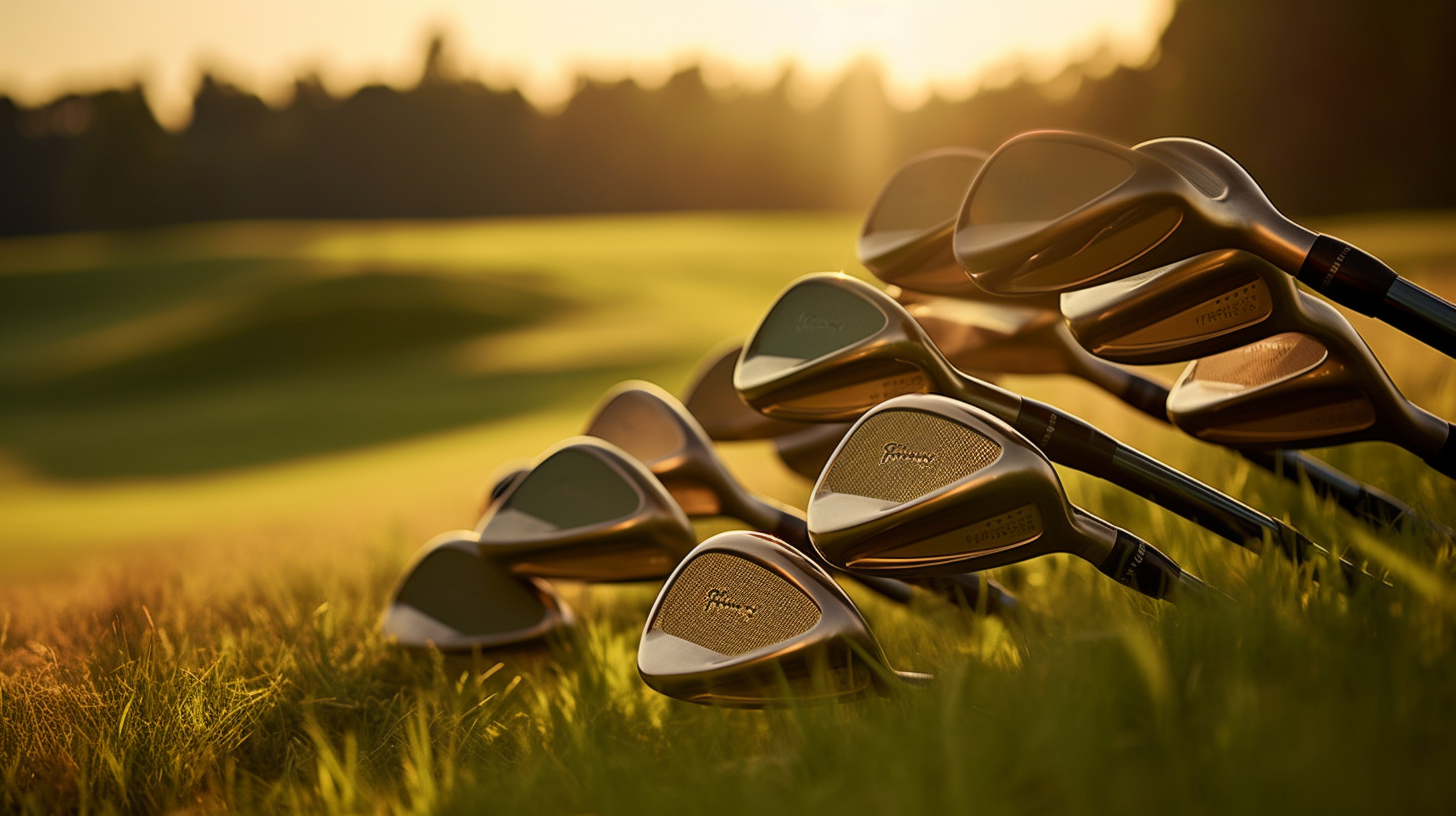Is learning optimal wedge setup and shots off-putting or does mastery inspire your inner short game artist?
Dialing in proper gapping, bounce and grind with technique mastery opens creative options to escape trouble while elevating scoring potential exponentially inside 100 yards.
Let’s dive into wedge fundamentals – from club choices to shot shapes – culminating in technology innovations that sharpen your short game.
What is a Wedge Golf Club?

A wedge golf club is a type of iron golf club that features a steep, highly lofted striking face designed to produce specialized golf shots. Wedges are shorter than traditional irons and feature heavier clubheads and wide soles for added forgiveness and consistency.
The loft on a wedge golf club typically ranges between 44 and 64 degrees or more. This creates a steep, descending blow with substantial backspin to stop the ball quickly on the green.
Wedges are used for close approach shots, getting out of bunkers or rough, flop shots that land softly, and other finesse shots requiring precision and control.
There are several common types of wedges used in a typical golfer’s bag:
Pitching Wedge: The pitching wedge features a loft between 44 and 48 degrees in most sets. It has moderate bounce and is the most versatile wedge for a variety of short game shots.
Most iron sets include a pitching wedge blended to match the set.
Gap Wedge: A gap wedge fills the yardage gap between the pitching wedge and the next shortest iron. It usually features 50-54 degrees of loft.
The name comes from filling the distance “gap” in your bag setup. Gap wedges feature slightly more bounce than pitching wedges.
Sand Wedge: As the name suggests, sand wedges are designed specifically for getting out of bunkers. They feature a wider sole and more bounce (55-58 degrees loft) to prevent digging.
The wider blade moves easily through sand compared to other clubs.
Lob Wedge: The lob wedge offers the highest loft at 60-64+, designed to produce the steepest, softest landing shots. The more vertical attack lets golfers control spin and land shots delicately on the green.
Lob wedges also provide versatility from tough lies in the rough or tight fairways.
Within these categories, wedges also utilize different grinds and sole types to perform best based on individual swing techniques and the turf conditions golfers typically encounter.
Importance of Wedges in Your Golf Bag

Most golfers carry between three to five wedges as part of a 14 club setup. Each wedge fills an important specialized role compared to woods and other irons off the tee, fairways and long approaches to the green.
Having a range of wedges expands shot versatility and scoring opportunities from 100 yards and in when precision wedge play separates the best short game performers.
Specifically, wedges excel when golfers need:
- Precise yardage gapping and distance control approaching the green
- Spin and height control on short iron shots and pitches
- Get up and down more consistently from greenside trouble
- Produce specialty shots like lobs over hazards and bunker explosions
- Control trajectory, curve and landing angle on tricky pin placements
- Confidence and consistency on tight lies requiring finesse around the green
While most golfers don’t hit wedges consistently from the tee box, they are vital weapons on approach when driving accuracy puts you slightly off target.
Creative shotmaking skill with various wedges can save dozens of strokes each round by avoiding bogies and creating birdie chances missed by golfers with only woods and long irons at their disposal.
Being competent with at least a pitching wedge, gap wedge and sand wedge should be minimum requirement for beginner and high handicap golfers as they develop their short game.
Highly skilled players may evolve to carry multiple precisely gapped wedges to dial in distances inside 125 yards. One of the best ways for amateurs to lower scores is by practicing their proficiency on all types of wedge shots.
Choosing the Right Wedges for Your Game

Not all wedges are created equal for each player or even course conditions commonly encountered. Most golfers evolve their wedge setup over years of experience identifying strengths, weaknesses and typical miss patterns.
Here are key factors to evaluate when selecting new wedges:
Swing Speed and Distance Gapping
Faster swinging players generally prefer weaker lofted wedges to prevent creating large yardage gaps between clubs. Slow swingers gravitate towards higher lofted clubs in each category to account for lower ball speed.
Testing various loft combinations on a launch monitor can define ideal gapping given your speed.
Most golfers fill wedge needs based on their existing iron set makeup. If your shortest iron is a pitching wedge, adding a 50-54 degree gap wedge makes sense before considering a 60 lob wedge.
Think about typical approach shot lengths on each hole rather than sticking to traditional loft specifications when creating your wedge continuum.
Turf Conditions
Fat shots are common with wedges, making bounce an important consideration. Players who sweep the ball cleanly can utilize lower bounce wedges.
Golfers who dig too much prefer wider soled higher bounce wedges to prevent digging. Also factor in the firmness and type of turf conditions faced.
Softer bunkers and greenside grass allows lower bounce whereas tight lies demand more bounce.
Most players need at least one higher bounce sand or lob wedge – especially for soft bunkers prevalent after rain. Grind and sole shape also impact effective bounce so test various setups with both square and open faces.
Shot Shaping and Trajectory Preferences
Wedges provide the most versatility to shape shots high or low, bend side to side curves and control landing angles.
Think through preferred shot shapes and trajectories to prioritize specialty wedges like 64 lob wedges for max height and soft landings or low penetrating gap wedge knockdowns.
Testing a range of wedges provides flexibility to execute more shots you physically struggle with using longer irons off tight lies. Don’t be afraid to carry multiple club options you can swap based on course setup and pin placements.
Practice Habits
Carrying extra wedges limits capacity to fill other specialty club needs like higher lofted fairway woods, driving irons or hybrids. Make sure your wedge choices align with practice habits.
If you’ll never open sand and lob wedges around the green in favor of simple bump and runs, customize selections differently.
No right or wrong setup exists across all players and courses. The best pros constantly test and tweak wedge makeup over a season adapting to current swing mechanics and competitive conditions.
Don’t fall in love with a single wedge look or brand – keep an open mind to change when your game evolves.
Gap Wedge vs Approach Wedge Debate
Many players debate eliminating their gap wedge in favor of an “approach wedge” – essentially a pitching wedge with stronger loft like 44-46 degrees.
The appeal involves carrying an extra hybrid or other long club while using the approach wedge on full swings between 105-130 yards. This centers typical wedge use closer from 50 yards and in.
For certain players and swing speeds, this setup fills needs off the tee while still allowing versatile shorter knockdown shots with a putter style swing.
However, removing the gap wedge also forces you to hit more three quarter and half shots with a lower lofted club.
Enhanced players excel at these finesse shots while high cappers inconsistent making crisp contact struggle without full gap wedge shots starting at 75 yards out.
If you pursue an approach wedge addition, make sure it features similar sole width and bounce characteristics as your pitching wedge to seamlessly fill that club’s roles.
High handicappers still leaning to compress irons fully should hesitate eliminating any wedge in favor of hybrids or utilities given their short game importance and scoring upside.
Mastering Wedge Shots Around the Green

Wedges require a different setup, swing and impact technique than full iron shots for maximum precision. The basics begin with adjustments to ball position, aim, weight shift and crisp contact.
From there, properly executing distance control, spin and trajectory finesse takes practice. Common wedge shots to master include:
Pitch Shots: Perfect to fly the ball onto the green with check and release when you must carry a front hazard or tier. Take a middle stance with weight forward in a putting posture.
Keep torso quiet with wrists hinging naturally. Let the loft provide carry distance rather than excess power from a steep plane.
Chip Shots: Best for running the ball onto a green using its contours to get close. Narrow stance with ball back fits a descending blow that imparts overspin from a sharp leading edge.
Keeping the face square is vital to monitor rollout distance. Great creative shot to play away from trouble.
Flop Shots: Essential for hitting over objects and stopping quickly on firm fast greens. Use the most lofted wedge to play ball further back with shaft lean. An open face reduces back spin and introduces curve. Let wrists hinge avoiding hand flip early release.
Contact slightly thin to create a vertical descent.
Splash Shots: When you must lob easily from a buried lie in thick rough or greenside bunker. Maintain loft and keep the handle forward with shaft angle matching spine tilt.
Explode sand or grass first avoiding ground before ball. Finesse distance, don’t muscle for extra height.
Practice ingraining proper technique on all wedge play variants, not just full swings. Control trajectory, spin rates and curved shapes adjusting swing path, face angles and speed.
Grooved wedge faces grip modern balls exceptionally – learn touch and finesse before trying dangerous hero shots. Golf coaches stress avoiding “automatic pilot” mistakes like flicking hands or swaying towards targets. Stay balanced, make crisp contact first.
Distance and shape follow trusted technique.
Drills like tossing balls into bunkers or rough then hitting precise yardage targets trains creative short game skill. As you improve, attempt sidehill, downhill and awkward stance lies to handle course trouble confidently.
Skilled wedge play should feel boring not scary – that assurance cuts five strokes a round.
Wedge Technology and Recent Innovations

Beyond deciding bounce, sole width and proper gapping – wedge clubhead design and engineering impacts performance. Companies like Cleveland, Callaway, Titleist and TaylorMade churn our new wedge innovations annually to win brand loyalty.
Recent improvements involve:
- Enhanced sole grinds like Callaway’s Mack Daddy Forged wedge for crisper turf interaction from varied lies and bunkers.
- Groove and face texture technology that imparts more consistent backspin on partial and full shots.
- Heavier clubheads in blade and cavity back designs boost stability and forgiveness on mishits.
- Custom shaft flex, grip and swingweight matching optimizes feel and control for player swing speeds.
- Expanded bounce, grind, loft and gap options provide flexibility to specialize wedge setups.
- Finish and cosmetic variety including custom engraving, paint fill and leading edge/sole wear inserts.
With club technology maxed out under USGA regulations, wedge design offers the most customization and performance upgrades as companies jockey for market share.
The blistering pace of change guarantees new wedge innovations every season from all major club manufacturers.
Expect more focus on specialized turf interaction capabilities and materials to increase spin on less than perfect lies whether wet rough or soft sand.
More custom fitting elements will tailor wedge configurations to student swing paths taking lesson feedback into account when selecting inventory. Wedges also make frequent new putter converts as low handicappers realize the value of crisper feel with a heavier forged head.
While exotic new wedge shapes emerge, most average golfers benefit more from lessons and practice over new gear.
But taking opportunity to test the latest wedges at demo days helps identify preference and gaps that may uncover simple fixes delivering more greenside consistency this season.
Small adjustments to wedge type, bounce or sole performance produce huge scoring benefits and renewed confidence.
Conclusion
Wedges are the most specialized clubs in a golfer’s bag, designed for specific shots that make or break scores inside 100 yards. Optimizing your wedge game through proper gapping, technique practice and testing the latest innovations pays huge dividends.
With so many new wedge technologies and custom options, visit a club fitter to identify the best configurations to match your speed, typical trajectories and course conditions. Groove sharper wedge play elevates scoring potential exponentially.



